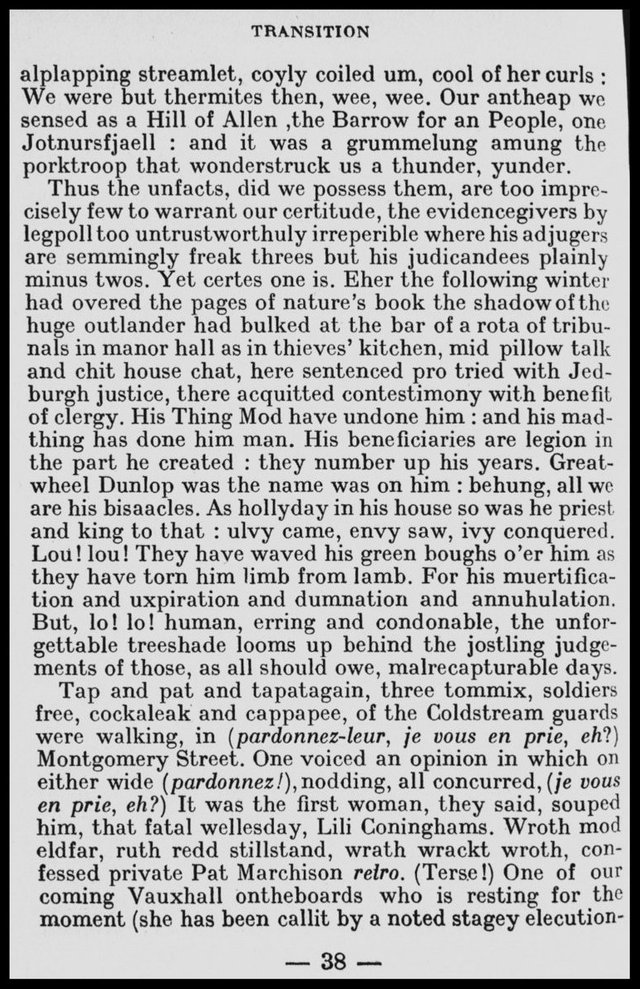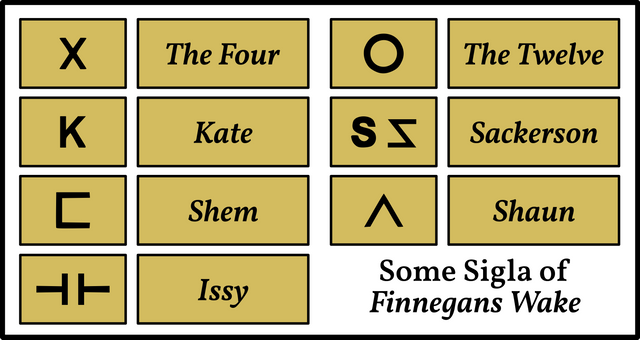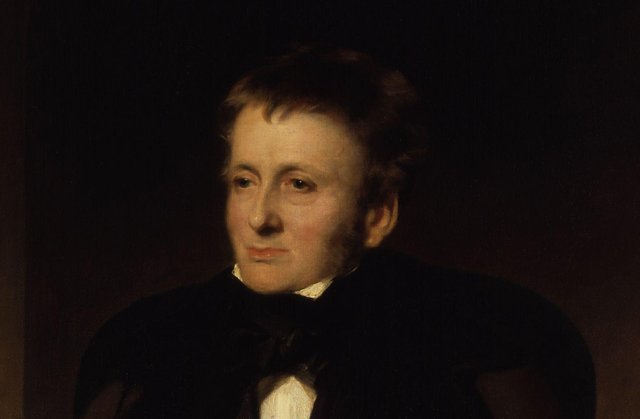With Schreis and Grida

Chapter I.3 of James Joyce’s Finnegans Wake—the Humphriad II—is a journalistic investigation into the HCE affair, especially HCE’s memorable encounter in the Phoenix Park with the Cad with a Pipe. We continue our study of the episode known as the Plebiscite—RFW 046.16-049.29—which documents the people’s response to the affair.
The paragraph we are now studying is one of four short paragraphs that were originally published as a single long paragraph when an early draft of this chapter appeared in June 1927 in Eugene Jolas & Elliot Paul’s literary journal transition. These paragraphs, which form a sort of introduction to the Plebiscite proper, remained yoked together when the first edition of Finnegans Wake was published in 1939. Their independence was restored when Danis Rose & John O’Hanlon brought out The Restored Finnegans Wake in 2010.
The evolution of this paragraph is particularly complicated. The only trace of it in the first draft of the Plebiscite is a single sentence, which would undergo a considerable metamorphosis before it achieved its final form. This draft was composed in November 1923:
The heroic shade looms up big, human, erring, forgivable behind the varied speeches of his fellow men & women. (Hayman 71 : James Joyce digital Archive)

The image evoked is of Tim Finnegan coming back to life during his own wake. When Joyce prepared a fair copy of this passage in the same month, he altered this sentence only slightly:
Big, human, erring, forgivable the unforgettable shade looms up behind the varied judgments of those unrecapturable days. (JJDA)
Another fair copy from November or December of the same year adds just two words to this:
Big, human, erring and forgivable the unforgettable shade looms up behind all the varied judgements of those unrecapturable days. (JJDA)
Over the next few years Joyce continued to tinker with the passage, but when he prepared a typescript in early 1927, prior to the serialization of Work in Progress in transition, this particular paragraph had changed little:
But big, human, erring and forgivable the unforgettable treeshade looms up behind all the varied judgements of those, as all should owe, malrecapturable days. (JJDA)
Compare this to the version that appeared in the 3rd number of transition on 1 June 1927:
But, lo! lo! human, erring and condonable, the unforgettable treeshade looms up behind the jostling judgements of those, as all should owe, malrecapturable days. (Jolas & Paul 38)

In the early 1930s, Joyce took out his copy of transition and revised this passage in preparation for the typesetting of Finnegans Wake, which began in 1936:
With schreis and grida, deprofound souspirs. Steady, sullivans! Mannequins, pause! Longtong’s breach is fallen down but Grannya’s spreed’s abroad. Ahdostay, feedailyones, and feel the Flucher’s bowls! For the total of your flout is not fit to fan his fettle, O! Have a ring and sing wohl! Chin, chin! Chin, chin! And of chorus all chimed chin with the eatmost boiviality. Swiping rums and beaunes and sherries and ciders and negus and citronades too. The strongers: Oho, oho, Mester Begge, you’re about to be bagged in the bog again. Bugg. But softees asighed: Ehu, for gasies! But, lo! lo! human, erring and condonable, the unforgettable treeshade looms up behind the jostling judgments of those, as all should owe, malrecapturable days. (JJDA)
Joyce was still not satisfied with this, and more changes would be made before the final printing took place. Some of these changes were errors, which have been corrected by Rose & O’Hanlon.

As we mentioned in the last article, this paragraph evokes the Mastication of the Host, which mythologist James Frazer explored in The Golden Bough. This motif was introduced in the opening chapter (005.27-006.23). But now the ingredients of Miss Hooligan’s Christmas Cake are replaced by drinks: rum, Beaune, sherry, cider, negus and citronnade. This is underscored by the preceding drinking toast, chin-chin.
Echoes
In Finnegans Wake the same stories are told over and over again. This paragraph is full of echoes of things we have already heard. Hymns and songs sung at Tim Finnegan’s wake are clearly audible, as are various statements made on the opening pages of the book:
- De Profundis
- London Bridge Is Falling Down
- Adeste Fideles
- Phil the Fluter’s Ball
- Miss Hooligan’s Christmas Cake
- Johnny I Hardly Knew Ye
| RFW | Text | RFW | Text |
|---|---|---|---|
| 005.37-38 | With their deepbrow fundigs | 047.01 | With ... deprofound souspirs |
| 005.29 ... 35 | hoolivans ... he’s steady | 047.01 | Steady, sullivans! |
| 013.36 | Minnikin Passe | 047.01-02 | Mannequins, pause! |
| 006.14-15 | Grampupus is fallen down but grinny sprids the boord. | 047.02-03 | Longtong’s breach is fallen down but Graunya’s spreed’s abroad. |
| 005.38 | and the dusty fidelios. | 047.03 | Ahdostay, feedailyones |
| 005.40 | Tee the tootal of the fluid hang the twoddle of the fuddled, O! | 047.03-04 | For the total of your flout is not fit to fan his fettle, O! |
| 011.04 | Fimfim fimfim. | 047.04-05 | Chin, chin! Chin, chin! |
| 005.31-32 | And all gianed in with the shoutmost shoviality. | 047.05-06 | And of chorus all chimed din width the eatmost boviality |
| 005.30-31 | There was plumbs and grumes and cheriffs and citherers and raiders and cinemen too. | 047.06-07. | Swiping rums and beaunes and sherries and ciders and negus and citronnades too. |
| 004.33 | Hohohoho, Mister Finn, you’re going to be Mister Finnagain! | 047.07-08 | Oho, oho, Mester Begge, you’re about to be bagged in the bog again. |
| 005.28 | Sobs they sighdid | 047.08 | softsies seufsighed |
| 011.14 | Ah, ho! | 047.08 | Eheu |
| 006.18 | But, lo, | 047.09 | But, lo! lo! |
| 022.11 | Assure a sure there! | 047.10 | ashu, ashure there |
| 004.11 | joshuan judges | 047.11 | jostling judgments |
HCE’s death was commemorated at the end of the preceding paragraph, so it is only fitting that he should be waked in this one.

Strongers and Softsies
In The Restored Finnegans Wake there are two colons in this paragraph. This implies that the expressions following them are lines of dialogue spoken by the characters named before them:
The strongers: Oho, oho, Mester Begge, you’re about to be bagged in the bog again. Bugge. But softsies seufsighed: Eheu, for gassies!
The strongers: The strangers. In Hiberno-English, strangers usually means foreigners, especially foreign invaders of Ireland. See RFW 259.23-24 for another example of stronger doing duty for stranger, and note the echo of Chin, chin! Chin, chin!
But softsies seufsighed: German: seufzen, to sigh.
Who are these strongers and softsies? The earlier phrase—Hohohoho, Mister Finn, you’re going to be Mister Finnagain (RFW 004.33)—was possibly spoken by the Four Old Men. But the Four are hardly strangers, let alone strong. If, however, the strongers are indeed the Four Old Men, then softsies must refer to Johnny MacDougal’s donkey. This makes sense, as Eheu does sound a bit like the braying of an ass: Hee-Haw!.

Perhaps the Strangers are the Twelve, who are referred to in the opening line of this paragraph: sullivans. The Twelve are often designated by this name (Glasheen 274). The Irish form of the name, Súilleabháin sounds like Súil Amháin, One Eye. The Twelve’s siglum—a circle representing the dial of a watch—looks like a single eye. They are also described at one point as a band of mercenaries (RFW 446.09-10). Joyce based them on the Sullivan Gang (known to their admirers as the Bantry Band), a group of Catholic Irish politicians from Bantry, Cork, who destroyed Charles Stewart Parnell’s reputation (Peter Chrisp). Joseph Campbell & Henry Morton Robinson agree with this interpretation, though Joyce hardly regarded the Twelve as good citizens:
With cries and groans and abyssal sighs, the twelve good citizens have re-enacted over him the traditional feast of primordial Finnegan’s wake. (Campbell & Robinson 70)
Alternatively, ALP’s elderly maid-of-all-work Kathe is identified with the historical figure of Kate Strong (eg 063.30). If she is the strongers, then HCE’s elderly manservant Sackerson would be softsies. This doesn’t seem too likely, but the concatenation of several s’s, as in softsies seufsighed, is characteristic of the Wake’s resident serpent.
In Finnegans Wake the word soft is often associated with Issy. The literal translation of Wagner’s Mild und leise is softly and gently. In 1937 an episode drawn from Chapter II.2 (School Nessans) was published in book form under the title Storiella as She Is Syung. If softsies is Issy, does this mean the strongers are her brothers Shem and Shaun?
The characters in Finnegans Wake have a tendency to blend into one another, so perhaps all these interpretations are valid.

Loose Ends
To conclude, let us tie up some loose ends.
German: Schrei, cry, shout, scream (noun).
Italian: grida, cries, shouts (verb). John Gordon adds: sighing and gnashing of teeth, of those in hell. Griding: grinding, grating. Words of Jesus; given context, it may be pertinent that according to Christian belief he “descended into Hell” on the day after the crucifixion. (Gordon 58.9)
deprofound souspirs Thomas De Quincey, Suspiria de Profundis (Sighs from the Depths). In this collection of essays in the form of prose poems De Quincey explores the hallucinogenic effects of opium on human memory and consciousness. They were written as a sequel to his more famous Confessions of an English Opium-Eater. There may also be an allusion to Oscar Wilde’s open letter De Profundis. Both works take their titles from the opening words of Psalm 130 in the Vulgate Latin translation: Out of the depths ...
French: soupirs, sighs : sous, below, under.
Mannequins, pause! Manneken Pis: a famous statue in Brussels of a child urinating. HCE’s Crime in the Park, or Original Sin, is often depicted as HCE peeping at two girls urinating amidst the foliage. In Sigmund Freud’s psychology the micturition of children is an important subject.

spreed’s abroad spreads the board (ie lays the table) : speeds abroad (ie hastens overseas, like Granuaile in the Prankquean Episode) : seed’s abroad (ie seed has been scattered). The latter fits in with the following allusion to Phil the Fluter’s bawls (balls, testicles) and flout (flute, penis), as John Gordon points out (Gordon 58.12). The sexual connotations of this paragraph are quite explicit: the mannequin is pissing, Long John’s britches are falling down, Diarmuid’s lover Gráinne spreads her legs, the ailing ones are asked to stay and feel the fucker’s balls.
German: Flucher, curser. When Tim Finnegan revives during his wake, he curses his mourners: Thanam ’on dhoul, D’ye think I'm dead? (Finnegan’s Wake).
to fan his fettle in fine fettle.
German: wohl, well : English: woe (anticipating the threnody at 047.09).
eatmost boviality, utmost joviality : eat ... bovine (beef is one of the funeral baked meats at HCE’s wake) : French: bouvoir, to drink.
Slang & Colloquialism: Swiping drinking hastily and copiously, drinking at one gulp.

beaunes Beaune, a French wine named for the wine capital of Burgundy.
negus A drink made of wine—or port—mixed with hot water, oranges or lemons, spices and sugar.
French: citronnade, lemonade.
Mester Begge Henrik Ibsen, Bygmester Solness, The Master Builder.
Begge ... Bugge Böögg, an effigy of winter burned at the culmination of Zurich’s spring festival Sechseläuten.
bog Besides the obvious allusion to bog bodies—well-preserved bodies of ritually sacrificed humans found in bogs across Europe, including Ireland—there is also the Slang: bog, toilet.
Bugge Alexander Bugge, a Norwegian historian and philologist. The son of the Norwegian philologist and folklorist Sophus Bugge, Alexander learned Irish to facilitate his study of Irish Medieval tracts. Among his publications are Bidrag til det sidste Afsnit af Nordboernes Historie i Irland [Contributions to the Last Chapter of the History of the Norsemen in Ireland] (1900), a critical edition of Duald Mac Firbis’ On the Fomorians and the Norsemen (1905), and Seafaring and Shipping during the Viking Ages (1909). In 1926 Joyce annotated Bugge’s Contributions (see Ferrer and Braslasu & MacArthur).

Bugge Bugger! (Damn! Blast!)
Eheu for gassies! Horace, Odes 2:14:1: Eheu fugaces, Postume, Postume, Labuntur anni [Latin: Alas! Postumus, O Postumus, the fleeting years are slipping by].
German: vergiss es! forget it!
threnning threne (a lament or threnody). Also threatening.
Danish treenige Gud, threefold God
German: trennen, to separate, to sever.
human, erring and condonable Alexander Pope, Essay on Criticism: to err is human, to forgive divine. Joyce replaced the original forgivable for the sake of the HEC motif.
the statues of our kuo the status quo.
Mandarin Chinese: kuo [guó, 國, 国], country, nation.

messchef the chef of a mess (a place where meals are eaten, especially in a military context) : mischief.
Mandarin Chinese: kuang [guāng, 先], light, beam, ray : bright
Mandarin Chinese: wáng [王] , king.
ashu ashure HCE’s characteristic stutter, or “hesit_e_ncy” of speech: the unmistakable expression of his guilt.
Mandarin Chinese: shù [樹, 树], tree.
treeshade Why did Tim Finnegan’s shade (ie ghost, spirit) become a treeshade (ie shadow of a tree)? Is there an allusion to the Holy Trinity (cf treenige above)? Or the Forbidden Tree of Knowledge? But Genesis comes before, not behind, Joshua and Judges.
all should owe all should know. Does this support the interpretation of treeshade as an allusion to the Tree of Knowledge?
And that’s as good a place as any to beach the bark of our tale.
References
- Viviana-Mirela Braslasu & Ian MacArthur, Norsemen in Ireland in Spree, Notebook VI.B.37, Genetic Joyce Studies, Issue 20, Centre for Manuscript Genetics, University of Antwerp, Antwerp (2020)
- Alexander Bugge, Bidrag til det sidste Afsnit af Nordboernes Historie i Irland [Contributions to the Last Chapter of the History of the Norsemen in Ireland], Part 1:
The Royal Race of Dublin, Part 2: Norse Elements in Gaelic Tradition of Modern Times, Part
3: Norse Settlements Round the Bristol Channel, Videnskabsselskrabets Skrifter, Volume 2, Historisk-filosofisk Klasse, Number 4, J Dybwad, Christiania (1900) - Alexander Bugge, Seafaring and Shipping during the Viking Ages, Saga-Book, Volume 6, Pages 13-27, The Viking Society for Northern Research, London (1909)
- Joseph Campbell, Henry Morton Robinson, A Skeleton Key to Finnegans Wake, Harcourt, Brace and Company, New York (1944)
- Daniel Ferrer, VI.B.17: A Reconstruction and Some Sources, Genetic Joyce Studies, Issue 15, Centre for Manuscript Genetics, University of Antwerp, Antwerp (2015)
- James George Frazer, The Golden Bough: A Study in Magic and Religion, One Volume Abridged Edition, The Macmillan Company, New York (1951)
- Adaline Glasheen, Third Census of Finnegans Wake, University of California Press, Berkeley, California (1977)
- David Hayman, A First-Draft Version of Finnegans Wake, University of Texas Press, Austin, Texas (1963)
- James Joyce, Storiella as She Is Syung: A Section of Work in Progress, Corvinus Press, London (1937)
- James Joyce, Finnegans Wake, The Viking Press, New York (1958, 1966)
- James Joyce, James Joyce: The Complete Works, Pynch (editor), Online (2013)
- Danis Rose, John O’Hanlon, The Restored Finnegans Wake, Penguin Classics, London (2012)
Image Credits
- An Irish Wake: Charles Williams (printer), S W Fores (publisher), A Satire on King George IV and his Wife’s Death and on the Magnificent Dinner Given by the Lord Mayor and Corporation of Dublin on 23 Aug 1821, British Museum, London, Public Domain
- See How He Rises!: McCarthay,’s Wake: McCarthay Comes to Life, C H Graves, The Universal Photo Art Company, Philadelphia (1897), Public Domain
- The Sullivan Gang: Anonymous Photograph, West Cork History, Public Domain
- Thomas De Quincey: John Watson Gordon (artist), National Portrait Gallery, London, Public Domain
- Manneken Pis: Jérôme Duquesnoy the Elder (sculptor), Manneken Pis, Brussels, © Walter (photographer), Creative Commons License
- Hôtel-Dieu, Beaune: © Stefan Bauer (photographer), Creative Commons License
- Alexander Bugge: Norsk biografisk leksikon [Norwegian Biographical Encyclopedia], Volume 2, NTB Scanpix, Public Domain
Useful Resources
- Joyce and the Middle Ages
- Jorn Barger: Robotwisdom
- Joyce Tools
- FWEET
- The James Joyce Scholars’ Collection
- FinnegansWiki
- James Joyce Digital Archive
- From Swerve of Shore to Bend of Bay
- John Gordon’s Finnegans Wake Blog
